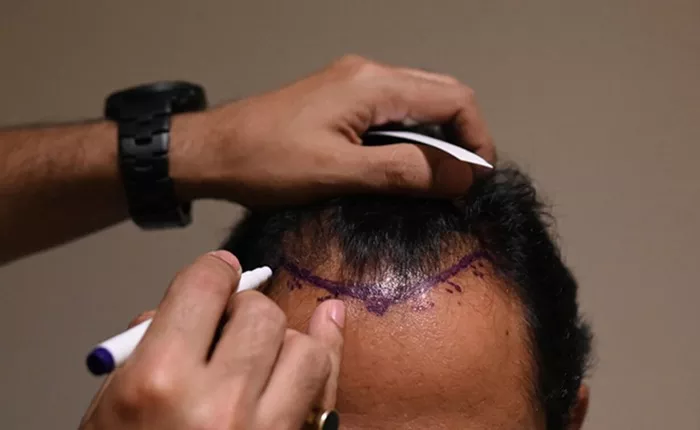Hair loss is a common issue that affects many people, and for those who are struggling with this problem, hair transplant surgery can be a permanent solution. But what exactly is a hair transplant? How does it work? And what are its benefits? In this article, we will discuss hair transplants in detail and understand how this procedure is performed.
What is a Hair Transplant?
A hair transplant is a surgical procedure in which hair follicles are taken from a donor area and transplanted to areas where hair is thinning or balding. The donor area is usually the back or sides of the head because the hair in these areas is genetically less prone to falling out. There are two main methods of hair transplantation: Follicular Unit Extraction (FUE) and Follicular Unit Transplantation (FUT). Both techniques aim to restore hair in areas where it has been lost, providing natural-looking results.
Difference Between FUE and FUT
In the FUE technique, the surgeon extracts individual hair follicles from the back of the head and transplants them to the balding areas. This technique is less invasive and leaves minimal scarring. Additionally, the recovery period is shorter. On the other hand, in the FUT technique, the surgeon removes a strip of skin from the back of the head and then dissects it into small follicular units for transplantation. This method may leave a linear scar and has a slightly longer recovery period.
Who is a Suitable Candidate for a Hair Transplant?
Not everyone experiencing hair loss is a suitable candidate for a hair transplant. The ideal candidate is someone who has sufficient hair in the donor area to cover the balding areas. Additionally, the candidate should be in good overall health and have realistic expectations about the results. During the consultation, the surgeon will assess the extent of hair loss, the quality of the donor hair, and the patient’s medical history to determine if they are a good candidate for the procedure.
The Hair Transplant Procedure
The hair transplant procedure typically takes several hours to complete, depending on the number of grafts required. The process begins with the surgeon administering local anesthesia to numb the donor and recipient areas. Once the area is numb, the surgeon will extract the hair follicles using either the FUE or FUT method. After the follicles are harvested, they are carefully transplanted into the balding areas. The surgeon will pay close attention to the angle and direction of the hair to ensure a natural-looking result.
Recovery After a Hair Transplant
The recovery period after a hair transplant is relatively short, but it is important to follow the surgeon’s post-operative instructions to ensure proper healing. Immediately after the procedure, the scalp may feel tender, and there may be some swelling or redness. These symptoms usually subside within a few days. Patients are advised to avoid strenuous activities, keep the scalp clean, and take prescribed medications to prevent infection and reduce swelling.
Results of a Hair Transplant
The results of a hair transplant are not immediate. After the procedure, the transplanted hair will go through a shedding phase, where the hair shafts fall out. This is a normal part of the process and should not cause concern. The hair follicles remain alive beneath the scalp and will begin to produce new hair within a few months. By the sixth month, the new hair will start to become noticeable, and by the twelfth month, the full results will be visible. The transplanted hair will continue to grow naturally and can be styled and cared for like normal hair.
Benefits of a Hair Transplant
One of the main benefits of a hair transplant is that it provides a permanent solution to hair loss. Unlike temporary solutions such as wigs or medications, a hair transplant offers long-lasting results. Additionally, the procedure is minimally invasive, and the recovery period is relatively short. The results are natural-looking, and the transplanted hair can be treated like normal hair. For many people, a hair transplant can significantly improve their appearance and boost their self-confidence.
Risks and Considerations
While hair transplants are generally safe, there are some risks and considerations to keep in mind. As with any surgical procedure, there is a risk of infection, bleeding, or scarring. Additionally, the results may vary depending on the individual’s hair type, the extent of hair loss, and the skill of the surgeon. It is important to choose a reputable clinic and an experienced surgeon to minimize the risks and ensure the best possible results.
Cost of a Hair Transplant
The cost of a hair transplant can vary depending on several factors, including the extent of hair loss, the number of grafts required, and the experience of the surgeon. While the cost may be a significant consideration for many people, it is important to remember that a hair transplant is an investment in your appearance and self-confidence. Many clinics offer financing options to make the procedure more affordable.
Conclusion
In conclusion, a hair transplant is a surgical procedure that can provide a permanent solution to hair loss. The procedure involves extracting hair follicles from a donor area and transplanting them to the balding areas. There are two main methods of hair transplantation: FUE and FUT. The recovery period is relatively short, and the results are natural-looking. While there are some risks involved, choosing a reputable clinic and an experienced surgeon can minimize these risks. A hair transplant can significantly improve your appearance and boost your self-confidence, making it a worthwhile investment for many people.
Related topics:
Side Effects of Hair Transplant Medication: All You Need to…
Hair Transplant for Lowering Hairline: A Detailed Guide
Hair Transplant to Fix Receding Hairline: A Complete Guide


